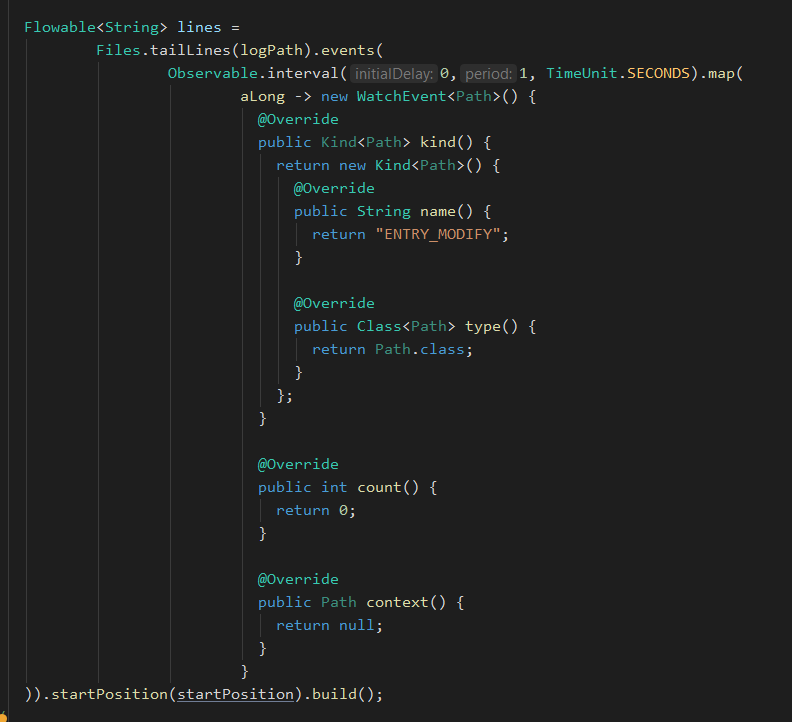rxjava2-file
Status: released to Maven Central
Requires Java 8+.
Flowable utilities for files:
- tail a file (either lines or byte[])
- trigger tail updates using Java 8 and later NIO
WatchServiceevents - or trigger tail updates using any Flowable
- stream
WatchEvents from aWatchService - tested on Linux, OSX (notes), Windows (notes)
- Note that
WatchServiceis problematic on OSX and Windows (see notes below) so your best bet is Linux!
Maven site reports are here including javadoc.
Getting started
Add this maven dependency to your pom.xml:
<dependency>
<groupId>com.github.davidmoten</groupId>
<artifactId>rxjava2-file</artifactId>
<version>VERSION_HERE</version>
</dependency>How to build
git clone https://github.com/davidmoten/rxjava2-file
cd rxjava2-file
mvn clean install Examples
Tail a text file with NIO
Tail the lines of the text log file /var/log/server.log as a Flowable<String>:
import com.github.davidmoten.rx2.file.Files;
Flowable<String> lines =
Files.tailLines("/var/log/server.log")
.nonBlocking()
.pollingInterval(500, TimeUnit.MILLISECONDS, Schedulers.io())
// set a private sun modifier that improves OSX responsiveness
.modifier(SensitivityWatchEventModifier.HIGH)
.startPosition(0)
.chunkSize(8192)
.utf8()
.build();or, using defaults of startPosition 0, chunkSize 8192, charset UTF-8, scheduler Schedulers.io():
Flowable<String> items =
Files.tailLines("/var/log/server.log").nonBlocking().build();
Tail a text file without NIO
The above example uses a WatchService to generate WatchEvents to prompt rereads of the end of the file to perform the tail.
To use polling without a WatchService (say every 5 seconds):
Flowable<String> items =
Files.tailLines("/var/log/server.log")
.events(Flowable.interval(5, TimeUnit.SECONDS))
.build();Tail a binary file with NIO
Flowable<byte[]> items =
Files.tailBytes("/tmp/dump.bin").blocking().build();Tail a binary file without NIO
Flowable<byte[]> items =
Files.tailBytes("/tmp/dump.bin")
.events(Flowable.interval(5, TimeUnit.SECONDS))
.build();Stream WatchService events for a file
Flowable<WatchEvent<?>> events =
Files
.watch(file)
.nonBlocking()
.scheduler(Schedulers.io())
.pollInterval(1, TimeUnit.MINUTES)
.build();Backpressure
When tailLines or tailBytes is used a conversion to Flowable occurs on the WatchEvent stream. This is desirable to handle large amounts of data being tailed in combination with a slow processor (e.g. a network call). The default strategy is BUFFER but the strategy is specifiable in the tailLines and tailBytes builders.
Non-blocking and blocking
Two alternatives are supported by the library for getting file change events from a WatchService. The nonBlocking() builder methods configure the stream to use events via WatchService.poll which is a non-blocking call (but may involve some I/O?). The blocking() builder methods configure the stream to use events via WatchService.take which is a blocking call.
So when specify nonBlocking() you end up with a stream that is asynchronous and blocking() gives you a synchronous stream (everything happens on the current thread unless of course you add asynchrony to the returned Flowable).
OSX
Apparently the WatchService can be slow on OSX (see here). Note that the first example above shows how to pass a special WatchEvent.Modifier which some find has a beneficial effect. Without that the WatchService can take >10 seconds to detect changes to the file system.
Windows
Detecting changes to files on Windows also seems problematic. See https://stackoverflow.com/questions/24306875/watchservice-in-windows-7-does-not-work.


